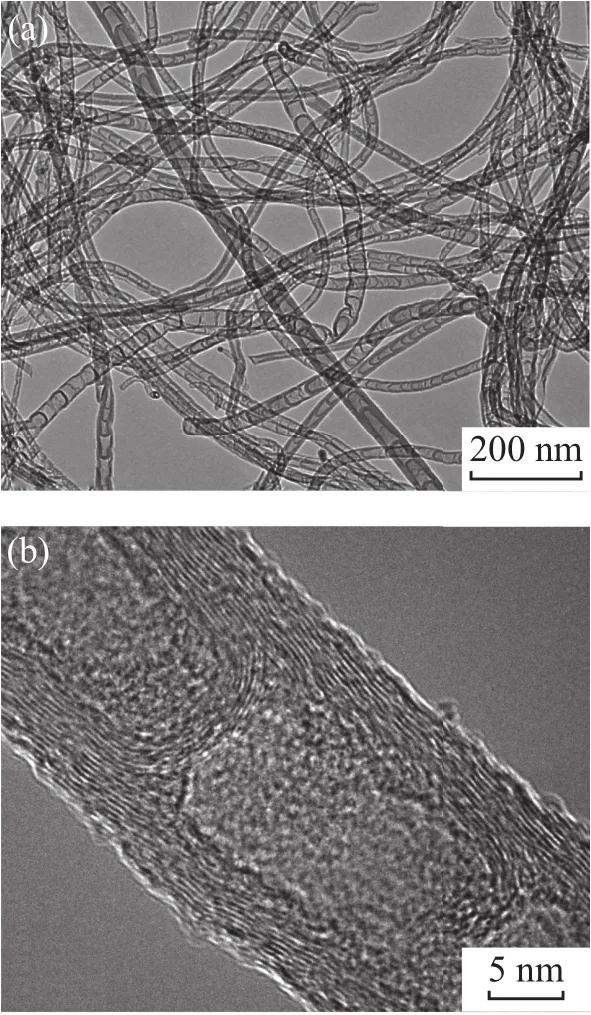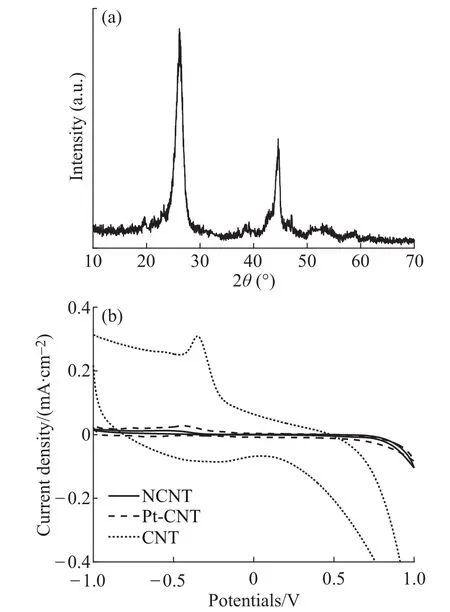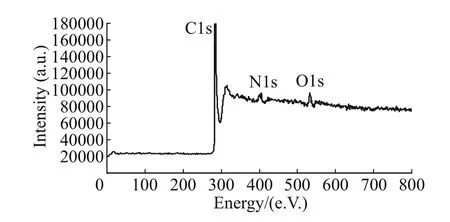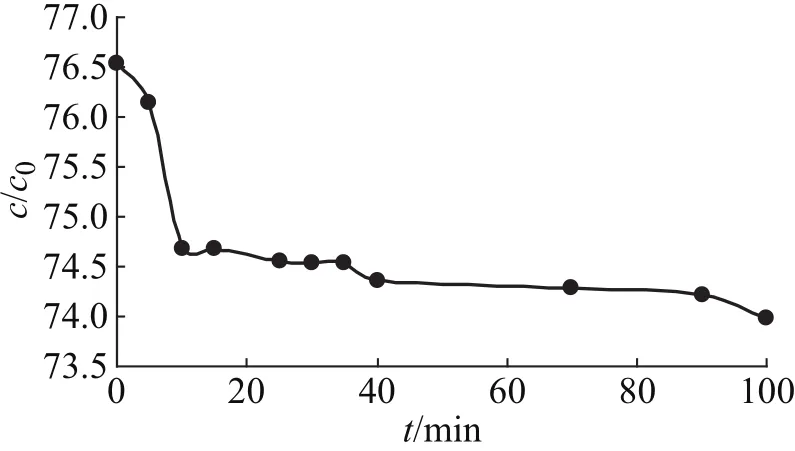Applications of Nitrogen-Doped Carbon Nanotubes in FuelCells and Water Treatment
JIN Hai-ying,WANG Ling-ling,BING Nai-ci, ZHU Lu-ping,WANG Li-jun
Applications of Nitrogen-Doped Carbon Nanotubes in FuelCells and Water Treatment
JIN Hai-ying,WANG Ling-ling,BING Nai-ci, ZHU Lu-ping,WANG Li-jun*
(Schoolof Urban Developmentand EnvironmentEngineering,ShanghaiSecond Polytechnic University, Shanghai201209,P.R.China)
Bamboo-like nitrogen-doped carbon nanotubes(NCNTs)have been synthesized by chemical vapor deposition (CVD)under 700°C.The butylamine and FeY zeolite have been used as precursor and catalyst,respectively.The electrocatalytic property of the NCNTs catalyst in oxygen reduction was examined by cyclic voltammetry.The results revealed thatthe NCNTs catalysthas higher catalytic activity than the commonly used Pt/C catalyst(Pt-CNTs,w(Pt/C)=20%, BASF).Anotherexample ofpotentialapplications,NCNTs were used as adsorbentin waste-watertreatment,and showed an excellentability to remove Pb2+in water.
nitrogen-doped carbon nanotubes;fuelcells;oxygen reduction;waste-water treatment
0 Introduction
Nitrogen-doped carbon nanotube(NCNTs)have been extensively studied in diverse fields including electrocatalysts,environment protection,wastewater treatment.Recently,intensive research efforts in reducing or replacing Pt-based electrode in fuel cells have led to the development of new oxygen reduction reaction(ORR)electrocatalysts,including Pt-based alloys[1],transition metal chalcogenides[2], enzymatic electrocatalytic systems[3],conducting poly(3,4-ethylenedioxythiophene)(PEDOT)–coated membranes[4],and carbon nanotube–supported metal particles[3-5].Apart from their use as the noble metalcatalyst supports,carbon nanotubes have shown outstanding electrocatalytic activities due to their unique electrical and chemical properties[6].Dai et al.[3-4,6-7]reported thatthe vertically aligned nitrogen-doped carbon nanotube arrays demonstrated high electrocatalytic activities forORR,which possessed a greatpotentialfor low-cost nonplatinum catalysts for fuel cell cathodes. However,as faras we are aware,there are limited studies which are aimed atthe applications of bamboo-like nitrogen doped carbon nanotubessynthesized by simple chemicalvapordeposition(CVD)method atFuelCells (FCs)cathode and adsorbentin waste-water treatment.
Thus,one of the main purposes of this study is to examine the feasibility of bamboo-like NCNTs synthesized by simple CVD method as metal-free cathodiccatalysts for oxygen reduction,and compare electrocatalytic activities of NCNTs with that of commercial Pt-carbon and CNTs as the cathodic catalystin FCs.To achieve these aims,the performance of NCNTs as catalyston cathodic oxygen reduction is elucidated by electrochemicalmeasurements.The electrocatalytic activitiesofNCNTsascatalystwere evaluated by comparison with the commercially available Pt-CNTs catalyst and CNTs particles,demonstrating obviously high catalytic activity.As another example of potentialapplications, the NCNTs were used asadsorbentin waste-watertreatment,and showed an excellent ability to remove Pb2+in water.
1 Experimental
1.1NCNTs Preparation
Bamboo-like NCNTs were synthesized at different reaction temperature by CVD as described previously[8],about 0.5 g FeY catalyst powder was placed in the central part of a horizontal quartz tube in the furnace.After the reaction chamber was evacuated and flushed with N2for severaltimes to remove oxygen and moisture,the reactor was heated to reaction temperature at a rate of 20°C/min in N2.Butylamine was then switched into the system for about 120 min,by the carrying gas of N2at a flow rate of 20 mL/min passing through a butylamine saturator at room temperature.The feed rate of butylamine was estimated to be about 10 mg/min.After that,the reactor was cooled to room temperature in N2and dark productwas obtained.Commonly,the purification process for NCNTs was as follows:NCNTs were firstly washed three times by w(HF)=20%solution,then soaked in w(HF)=20%solution overnightand finally heat-dried at 105°C for 2 h.Unless otherwise stated, allchemicals were purchased from Sigma-Aldrich and used withoutany further purification.Allthe solutions were prepared with doubly distilled water.
1.2Materialand ElectrochemicalAnalyses
As the previous paper[9],the electrochemical performance ofthe NCNTs(NCNTs/GC),Pt/C(Pt/C/GC) or CNTs(CNTs)catalysts were examined by cyclic voltammetry(CV)in 0.1 mol/L KOH solution,which was carried outatroom temperature in a three-electrode cellconnected to a CHI 760C workstation(CH Instrument,USA).Aglassy carbon disk with an apparentsurface area of0.072 cm2was used as a working electrode. Ag/AgCl and platinum foil served as reference and counter electrodes,respectively.A thin film electrode was prepared similarly to the literature procedure[10]. Briefly,a suspension of Pt/CNx(or Pt/CNT)catalyst with a concentration of 1.0 g/L was made by ultrasonically dispersing 1 mg Pt/CNxin 1 mL ethanol–water (1:1,V/V)solution.Then 5 mL NCNTs,Pt/C or CNTs suspension was dropped onto the glassy carbon disk.When the glassy carbon disk was dried in air, 5 mL diluted Nafion solution(w=5%,Alfa Aesar) was dropped onto the catalystto actas binderand electrolyte.Then CV curves were recorded in the potentialrange of-1.0 V to 1.0 V ata scan rate of 0.1 V/s. CommercialPt/C catalystnanoparticle powderwas purchased from Alfa Aesar Chemicals Co.
1.3Water Treatment Experiments
The otherchemicals used were obtained from Beijing Chemicals Co.(Beijing,China).For the experiment,PbCO3were used as the sources of Pb(II).The pH values of the solutions were adjusted using HCl. Solutions containing concentrations of Pb(II)were prepared and adjusted to pH4 forthe Pb(II)solution.Then, 0.05 g ofthe NCNTs sample was added to 25 mL ofthe above solution understirring.Aftera specified time,the solid and liquid were separated and Inductively Coupled Plasma-Optical Emission Spectroscopy(Optima 5300DV)was used to measure the Pb(II)concentrationin the remaining solutions.The adsorption isotherm wasobtained by varying the initialPb(II)concentration and stirring for 3 h atroom temperature(20°C).
2 Results and Discussion
Figure 1(a)showsthe typicaltransmission electron microscopy(TEM)images ofthe nanotubularproducts, which were synthesized at 700°C.It is seen that the butylamine NCNTs exhibitthe characteristic bamboolike,defective appearance of NCNTs with the average outer diameter of around 23.5 nm.In order to observe the microstructure of NCNTs,the typical high resolution TEM(HRTEM)images of the samples are shown in Figure 1(b),which further display the bamboo-like structure with multi-wall in which the tube inside is separated into a series of compartment.The walls of the“bamboo”segments exhibitsome disorderordefect sites,which is similar to the previous reportusing pyridine as the nitrogen precursor[11].

Fig.1 TEM(a)and HRTEM(b)images of nitrogen-doped carbon nanotubes
X-ray diffraction(XRD)patterns of NCNTs are shown in Figure 2(a).The diffraction peaks at 26.1°and 46.7°for NCNTs could be attributed to(002)and (100)planes of graphite,respectively.The XRD patterns revealed thatgraphite structure have been synthesized under 700°C reaction temperature.As known, the annealing experimentalstudies on both NCNTs and films have indicated that the graphite-like nitrogen is more stable than the pyridine-like nitrogen[12].Hence nitrogen atoms would like to conform to the graphitelike configuration for higher stability under high reaction temperature.
Analogous to the previous study[13-14],Figure 2(b) describes the results of CV experiments with NCNTs electrodes in O2saturated 0.1 mol/L KOH aqueous solution.Itcan be seen thatan obviousreduction peaksfor NCNTs were observed atthe potentialof-0.30 V and the electrocatalytic currentdensity of NCNTs-700°C was about2.0 mA/cm2.

Fig.2 The XRD patterns(a)of NCNTs and cyclic voltammograms(b)of NCNTs,Pt-CNT and CNT
For electrochemical comparison,commercial Pt-CNTs with w(Pt)=20%and CNTs catalyst were tested under the same experimental conditions and the corresponding CVcurveswere displayed in Figure 2(b).As seen,no obvious reduction peak could be observed for the CV curve of the CNTs,indicating thatitis catalytically inactive for oxygen reduction.Two typical reduction peaks appear for the CV curves of the Pt-CNTs catalysts at-0.75 V and-0.35 V,which were significantly lower than that of NCNTs,arising from the reduction of the oxygen with the reduction process of a four-electron pathway in 0.1 mol/L KOH aqueous solution[7].The electrocatalytic currentof Pt-CNTs catalystswere 0.25 mA/cm2and 0.30 mA/cm2which were obviously lower than that of NCNTs.By comparing, NCNTs catalysts obviously indicated better potential applications in FCs than Pt-CNTs catalyst and CNTs particles.These results indicated that NCNTs catalyst has much better electrocatalytic performance than Pt-CNTs and CNTs.
It should be emphasized that before the cyclic voltammetry experiment,the iron catalystresiduesused for the growth of NCNTs were removed by chemical purification,which was evidenced by X-ray photoelectron spectroscopy(XPS)analysis(Figure 3).Thus, the role of iron catalyst residues in the observed electrochemical activities of NCNTs could be omitted.It seems that NCNTs have a greatpotentialto be used as an alternative to Pt-CNTs for ORR in FCs.

Fig.3 XPS survey for NCNTs
Clean water,free of toxic chemicals and pathogens,is vital to the world’s health,and is also a critical feedstock in a variety of key industries.Considerable attention has been paid to the environmentalproblems involving water treatmentin recentyears. The development of nanoscience and nanotechnology suggests thatmany ofthe currentwater-treatmentproblems could be resolved or greatly ameliorated by using nanosorbents,nanocatalysts,bioactive nanoparticles,catalytic membranes with nanostructures,and so on[15].Herein,we used the NCNTs to investigate their applications in water treatment.Lead is considered as primary highly toxic pollutants in water resources and their efficient removal from water is of great importance.The solid line in Figure 4 showsthatwhen 0.05 g of NCNTs was added to 25 mL lead solution with an initialconcentration of10.63 mg/L and adjusted to pH4 atroom temperature(20°C),Pb(II)could be removed almost completely in a short time;the adsorption capacity was measured as 5.3 mg/g.The mechanism for the removal of the metal and anionic contaminant was proposed to involve surface complexation and ion exchange between the nitrogen atom surface and the toxic ions in the aqueous solution.

Fig.4 Adsorption rate of Pb(II)on NCNTs
3 Conclusions
In summary,the nitrogen-doped carbon nanotubes synthesized by simple CVD were applied successfully as the metal-free catalyst for cathodic ORR in FCs and showed better electrocatalytic activity than the traditional Pt-CNTs catalyst,suggesting that NCNTs were a superb alternative to Pt-CNTs for FCs although the NCNTs loading still needs to be optimized.The NCNTs showed an excellent ability to remove heavy metalions Pb(II)and are expected to be usefulin manyotherapplications.
[1]TERRONES M,TERRONES H,GROBERT N,etal.Efficient route to large arrays of CNxnanofibers by pyrolysis of ferrocene/melamine mixtures[J].Appl.Phys.Lett., 1999,75:3932-3934.
[2]HAN W Q,KOHLER-REDLICH P,SEEGER T,et al. Aligned CNxnanotubes by pyrolysis of ferrocene/C60underNH3atmosphere[J].Appl.Phys.Lett.,2000,77:1807-1809.
[3]XIONGW,DU F,LIU Y,etal.3-Dcarbon nanotube structures used as high performance catalyst for oxygen reduction reaction[J].J.Am.Chem.Soc.,2010,132:15839-15841.
[4]LIUH,ZHANGY,LIR,etal.Nitrogen-doped carbon nanotubes with high activity for oxygen reduction[J].Carbon, 2010,48:1498-1507.
[5]WANG X,LIX,ZHANG L,etal.N-doping of graphene through electrothermal reactions with ammonia[J].Science,2009,324:768-771.
[6]TANG Y,ALLEN B L,KAUFFMAN D R,etal.Electrocatalytic activity of nitrogen-doped carbon nanotube cups [J].J.Am.Chem.Soc.,2009,131:13200-13201.
[7]CHEN Z,HIGGINS D,TAO H,et al.highly active nitrogen-doped carbon nanotubes for oxygen reduction reaction in fuelcellapplications[J].J.Phys.Chem.C,2009, 113:21008-21013.
[8]WANG L J,WANG J W,LIQ H,etal.Synthesis and char acter ization of carbon nanotubes with differ entamountof nitrogen[J].Chinese JournalofInorganic Chemistry,2007, 23:1035-1039.
[9]YUE B,MA Y,TAO H,et al.CNxnanotubes as catalyst supportto immobilize platinum nanoparticles formethanol oxidation[J].J.Mater.Chem.,2008,18:1747-1750.
[10]LI L,XING Y.Pt-Ru nanoparticles supported on carbon nanotubes as methanol fuel cell catalysts[J].J.Phys. Chem.C,2007,111:2803-2808.
[11]FENG L,YAN Y,CHEN Y,et al.Nitrogen-doped carbon nanotubes as efficientand durable metal-free cathodic catalysts for oxygen reduction in microbial fuel cells[J].Energy and Environmental Sci.,2011:1892-1899.
[12]JIN H,BING N,WANG L L,et al.Synthesis of nitrogen incorporated carbon nanotubes with differentdiameters by catalytic pyrolysis of butylamine[J].Chem.Res.Chinese Universities,2011,27:903-905.
[13]LIU G,LI X,GANESAN P,et al.Development of nonprecious metal oxygen-reduction catalysts for PEM fuel cells based on N-doped ordered porous carbon[J].Applied Catalysis B:Environmental,2009,93:156-165.
[14]MA Y,JIANG S,JIANG G,et al.CNxnanofibers converted from polypyrrole nanowires as platinum supportfor methanoloxidation[J].Energy Environ.Sci.,2009,2:224-229.
[15]SAVAGE N,DIALLO M S.Nanomaterials and water purification:Opportunities and challenges[J].J.Nanopart. Res.,2005,7:331-342.
氮掺杂炭纳米管的合成及其在燃料电池和水处理方面的应用
靳海英,汪玲玲,邴乃慈,朱路平,王利军
(上海第二工业大学城市建设与环境工程学院,上海201209)
在反应温度为700°C下,通过化学气相沉积(CVD)方法合成了竹节状氮掺杂炭纳米管。仲丁胺和负载铁Y型分子筛分别作为前驱体和催化剂。氮掺杂炭纳米管在氧化还原反应中的电催化性能是通过循环伏安方法检测的。循环伏安的检测结果表明氮掺杂炭纳米管的催化活性比负载铂的炭纳米管高。在含有Pb2+离子的废水处理方面,氮掺杂炭纳米管也表现了较好的应用潜力。
氮掺杂炭纳米管;燃料电池;氧化还原;废水处理
O69
A
1001-4543(2013)04-0285-05
2013-03-22;
2013-10-29
王利军(1972–),男,河南郑州人,教授,博士,主要研究方向为功能氮掺杂碳纳米管材料制备及应用、SAPO分子筛材料新合成方法及应用,电子邮箱ljwang@sspu.edu.cn。
国家自然科学基金(No.21101105)、煤炭联合基金(No.51174274)、上海市曙光计划(No.09SG54)、上海市创新教育(No.12ZZ195)资助

